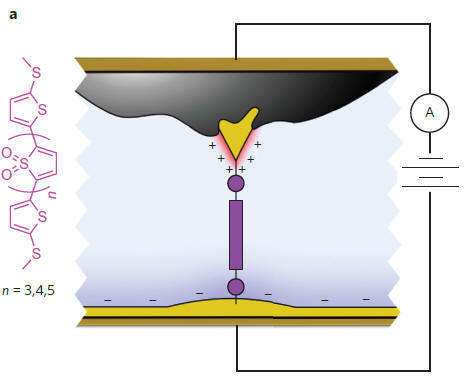Scientists have created an effective single-molecule diode

A group of physicists from the engineering school of applied sciences at Columbia University has developed a technology for producing full-fledged diodes of just one molecule in size. The work was carried out under the guidance of the assistant professor of applied physics Lata Venkataraman.
Their "molecular diode" works more efficiently than the analogues created earlier, and has every chance of becoming the first nano-diode suitable for creating nanodevices. The work was published on May 25 in the journal Nature Nanotechnology .
')
Today's miniaturization of electronics occupied the minds of scientists in the last century. In 1974, A. Aviram and M. Ratner suggested in their work that a single molecule could work as a rectifier, and thus marked the beginning of modern microelectronics.
Since then, researchers have found that single molecules associated with metal electrodes (monomolecular connection) can be made to play the role of various elements of electrical circuits - resistors, switches, transistors and diodes. In this case, quantum effects directly participate in this behavior of molecules.

For 40 years, attempts have been made to create an asymmetric molecule that emulates the work of a classical diode with pn junctions. But the previous nanodiodes had low conductivity, poor rectification coefficients (ratio of throughput to shut-off) and required high voltages for operation.
The diode created by the researchers, created on the basis of an oligomer (molecules in the form of a chain of identical units) of thiophene dioxide, has a rectification coefficient of more than 250 (5 times higher than previous attempts) and operates at voltages from 370 mV.
“Our approach made it possible to create a single-molecule diode with a rectification rate of more than 250 and a permitted current of up to 0.1 μA,” says Venkataraman. - The creation of devices with one-molecule active elements has long been a dream of scientists involved in nanotechnology. This goal, which since 1974 has been the "holy grail" of molecular electronics, is the smallest possible size that an electronic device can have. "

The approach of scientists is that not only the molecule was asymmetric, but also its environment. Good results were achieved by placing it in an ionic solution and using gold electrodes of different sizes.
“It's amazing that we can develop and create a molecular size circuit that can do something practical,” says Venkataraman. “This is actually a triumph, to create such a thing that is impossible to see with the naked eye, but which at the same time works as intended.”
Source: https://habr.com/ru/post/367203/
All Articles